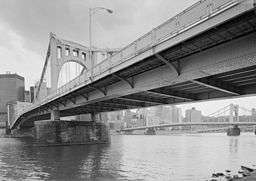Andy Warhol Bridge
| Andy Warhol Bridge | |
| Seventh Street Bridge | |
| Suspension bridge | |
 From north bank of the Allegheny River, looking southwest, downtown Pittsburgh in background, Roberto Clemente Bridge at right.
Shows main plate girder (bearing compressive forces) and sidewalk support. | |
| Official name: Andy Warhol Bridge | |
| Named for: Andy Warhol | |
| Country | United States |
|---|---|
| State | Pennsylvania |
| County | Allegheny |
| Municipality | Pittsburgh |
| Road | Seventh Street 2 lanes |
| - Sidewalks | Each side |
| Crosses | Allegheny River |
| Coordinates | 40°26′46″N 80°00′05″W / 40.44611°N 80.00139°WCoordinates: 40°26′46″N 80°00′05″W / 40.44611°N 80.00139°W |
| Length | 1,061 ft (323 m) |
| - Main span | 442 ft (135 m) |
| - Side spans | 442 ft (135 m) |
| - All spans | 884 ft (269 m) |
| Width | 62 ft (19 m) Vertical clearance above 78 ft towers |
| - Roadway | 38 ft (12 m) |
| Clearance | 83.5 ft (25 m) |
| - Navigational | 40.1 ft (12 m) |
| Number of spans | 3 |
| Builder | American Bridge Company |
| Design | Self-anchored suspension |
| Material | Steel |
| Built | 1925–1926 |
| - Opened | June 17, 1926 |
| Maintained by | Allegheny County |
 Location of the Andy Warhol Bridge in Pennsylvania  Andy Warhol Bridge (the US) | |
| Wikimedia Commons: Andy Warhol Bridge | |
Andy Warhol Bridge, also known as the Seventh Street Bridge, spans the Allegheny River in Downtown Pittsburgh, Pennsylvania and is the only bridge in the United States named for a visual artist. It was opened at a cost of $1.5 million[1] on June 17, 1926 in a ceremony attended by 2,000.[2]
Named for the artist Andy Warhol, a Pittsburgh native, it is one of three parallel bridges called The Three Sisters, the others being the Roberto Clemente Bridge and the Rachel Carson Bridge. The Three Sisters are self-anchored suspension bridges and are historically significant because they are the only trio of nearly identical bridges – as well as the first self-anchored suspension spans — built in the United States.
The bridge was renamed for Warhol on March 18, 2005, as part of the tenth anniversary celebration for the Andy Warhol Museum. The museum is nearby at 117 Sandusky Street, a street which leads to the bridge from the north side of the river on Pittsburgh's North Shore.
On August 11, 2013, the Andy Warhol Bridge was covered with 580 knitted and crocheted panels in a yarn bombing project known as Knit the Bridge that lasted for four weeks.[3]

This is the third Bridge on the site, the first being demolished in early 1884, it's replacement, began construction in 1884,[4] and was open to traffic by 1887.[5]
Gallery
- Andy Warhol Bridge
- Banner for the bridge's namesake, Andy Warhol
 "Knit the Bridge" yarn bombing event on the bridge in August 2013
"Knit the Bridge" yarn bombing event on the bridge in August 2013
See also
References
- ↑ https://news.google.com/newspapers?id=LUMqAAAAIBAJ&sjid=GkoEAAAAIBAJ&pg=6868%2C6791474
- ↑ The Pittsburgh Press - Google News Archive Search
- ↑ Pittsburgh Bridge Gets a ‘Yarn Bomb’ Makeover | TIME.com
- ↑ "A novel and profitable plan of construction for the new seventh street bridge". Pittsburgh Post-Gazette. 23 Nov 1883. p. 2. Retrieved 5 October 2018 – via newspapers.com.
(make the piers) longer than they are now which is sixty-six feet
- ↑ "Local Laconics". Altoona Times. 22 Jan 1887. p. 4. Retrieved 5 October 2018 – via newspapers.com.
Levi H. Kantner, the 16-year-old son of Mr. D. T. Kantner, of the Altoona Gas Works, had the pleasure of being the first bicycler to cross the new Seventh street bridge on a wheel. Levi Kantner won't be beat in anything he undertakes that is, he won't if he can help it.
- Pohla Smith (2005). Warhol Bridge Dedication: story by Pittsburgh Post-Gazette. Retrieved April 23, 2006.
External links
![]()
- Historic American Engineering Record (HAER) No. PA-490-B, "Three Sisters Bridges, Seventh Street Bridge, Spanning Allegheny River at Seventh Street, Pittsburgh, Allegheny County, PA", 3 photos, 1 color transparency, 1 photo caption page
- Seventh Street Bridge at Structurae
- Seventh Street Bridge at pghbridges.com
- Andy Warhol (Seventh Street) at BridgeMeister.com